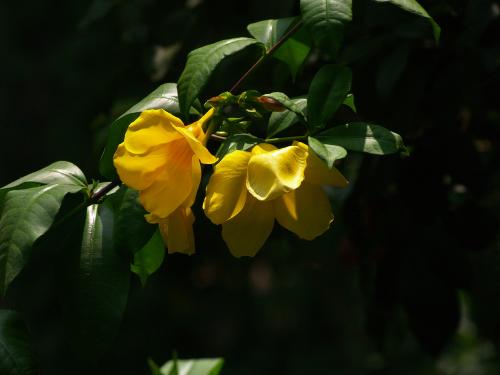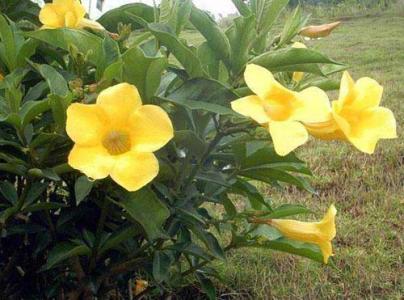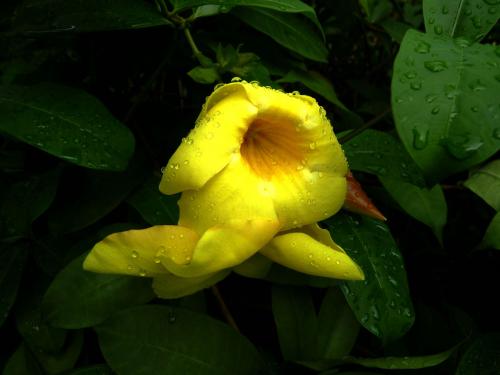The planting mode of yellow cicada flower
The first way-- sowing and planting
First of all, the seeds of yellow cicadas should be collected first, but the seeds of yellow cicadas are not hidden for a long time, so it is best to sow after picking.
The second way-- pressing planting
Select the branch near the ground, then cut the branch and press it into the soil, wait for the yellow cicada to take root and then separate it from the mother plant, which is called striping propagation.
The third way-cutting planting
There are many kinds of cuttings, and the highest survival rate of yellow cicadas is water cutting. First cut the well-developed branches, then insert them into a glass bottle filled with water, then change the water frequently until it takes root, and finally plant it into the soil.

All right, that's all for today. I hope the editor's content can make you know more about Huang Cicada! Thank you!
How to plant yellow cicadas
Yellow cicada flowers are often used for garden greening, with dense plants, green leaves, bright and bright flowers, very eye-catching, suitable for large and medium-sized potted plants, decorating living rooms, balconies, parks, shopping malls, meeting venues and other large indoor space, the effect is very good. Next, with the editor, let's take a look at how to grow yellow cicadas and how to grow yellow cicadas.
An introduction to Huang Cicada
Yellow cicada (scientific name: Allemanda neriifolia Hook.): evergreen shrub, the plant grows erect, height is about 2 meters, potted plants are generally controlled at about 1 meter. Leaves 3 to 5 whorled, leaf blade elliptic or oblanceolate, 5 cm to 12 cm long, 1.5 cm to 4 cm wide, pubescent. Cymes, flowers golden, throat with orange-red stripes, Corolla broad funnel-shaped, 5 lobes, and overlap to the left or right, Corolla base dilated, internal stamens 5. Capsule globose, with long spines. The florescence is from May to June. Native to the southern United States and Brazil, distributed in tropical America, China for the introduction of cultivation. Used for garden greening, dense plants, green leaves, bright flowers, very eye-catching, suitable for large and medium-sized potted plants, decorating living rooms, balconies, parks, shopping malls, venues and other large indoor space, the effect is very good.
1. Morphological characteristics
Branches: yellow cicada is an erect shrub plant, 1-2 meters tall, with milk; branches gray-white.
Leaves: yellow cicada leaves 3-5 whorled, entire, elliptic or Obovate-oblong, 6-12 cm long and 2-4 cm wide, apex acuminate or acute, base cuneate, leaf surface dark green, leaf dorsal light green, glabrous except dorsal midvein and lateral veins pubescent; leaf veins flattened on leaf surface, raised on leaf back, lateral veins 7-12 on each side, anastomosing before reaching margin; petiole extremely short, with glands at base and between axils.
Flowers: yellow cicada terminal Cymes; total pedicels and pedicels chaff-shaped pilose; flowers orange-yellow, 4-6 cm long, mouth opening ca. 4 cm in diameter; bracts lanceolate, inserted at base of pedicel Calyx deeply 5-lobed, lobes lanceolate, inner base with a few glands: Corolla funnelform, with reddish-brown stripes, lower Corolla cylindric, no more than 2 cm long, 2-4 mm in diameter, base dilated, throat enlarged upward into a Corolla, about 3 cm long, 1.5 cm in diameter, tip 5-lobed, Corolla lobes covering left, lobes oval or rounded, apex obtuse, 1.6-2.0 cm long It is about 1.7 cm wide. Stamens 5, inserted in Corolla tube throat, filaments short, base pilose, anthers ovoid, apex obtuse, base rounded; disk fleshy, surrounding ovary base; ovary entire, 1-loculed, style filiform, stigma tip obtuse, base annular. The florescence of yellow cicada is from May to August.
Fruit: capsule of yellow cicada globose, spiny, ca. 3 cm in diam.; seeds flattened, with membranous margin, ca. 2 cm long, 1.5 cm wide. The fruit period of yellow cicada is from October to December.
2. Ecological habits
Yellow cicadas like high temperature, wet, sunny, slightly resistant to semi-shade. Suitable for fertile, well-drained soil. Do not bear the cold, avoid frost, encounter long-term 5-6 ℃ low temperature, branches and leaves suffer.
Yellow cicada likes fertile and humid sandy loam, clayey soil grows poorly, and avoids stagnant water and saline-alkali land. More resistant to moisture, not resistant to drought, the soil should always be kept moist. The suitable temperature for growth is 18-30 ℃, and it can grow normally when it is above 35 ℃. During the winter dormancy, the optimum temperature is 12-15 ℃, which can not be lower than 10 ℃, and the plants below 5 ℃ are damaged by freezing.
III. Mode of reproduction
1. Sowing and reproduction
The yellow cicada bears fruit after flowering, the sprouting fruit has soft thorns, the seed has wings, it is not suitable to hide for a long time, it is appropriate to sow with picking, and 1-year-old seedlings can come out of the nursery.
2. Striping propagation
The striping is carried out in the rainy season, the cut epidermis of the branches near the surface is pressed into the soil, and it takes root about 2 months later, which can be separated from the mother plant.
3. Cuttage propagation
Water insertion is particularly easy to take root, and can be carried out during the growing season. Cut 30-40 cm long branches, split 4-6 cm with a knife at the lower end, and insert them into a glass filled with water. The temperature is more suitable in spring and autumn, and roots can grow in about 2-3 weeks. Due to the high temperature in summer, the water is easy to deteriorate, so change the water every two days.
Cuttage seedlings are often used in production. After the temperature rises steadily from late March to mid-April, half-year-old to 2-year-old branches are cut as cuttings, closely inserted into wet sand or sand bed, and moisturized by spray. When the temperature is above 20 ℃, roots can be rooted in about 20 days, and can be moved to nursery or pot planting in about 40 days.
4. Toxicity of yellow cicada
The milk of the plant of the yellow cicada is poisonous, human and animal poisoning will stimulate the heart, circulatory system and respiratory system, and pregnant animals will have a miscarriage.
Cultivation techniques of yellow cicada
1. Environment
Potted with peat soil or rotten leaf soil, like warmth, the lowest temperature in winter should be above 15 ℃; strong positive plants can be cultivated in outdoor sunlight in summer, and there is direct sunlight in winter. Like a humid environment. The basin soil keeps sufficient moisture from spring to autumn and reduces watering appropriately in winter to keep the basin soil slightly tidal.
2. Water and fertilizer
During the growing season, the soil is often kept moist and fertilized every 20 days to promote exuberant branches and blossoms. Control moisture during dormancy. Plants generally do not need to fertilize after frostbite, watering should be moderate, to control water, because convalescent plants are difficult to absorb nutrients, watering too much, plants can not absorb, but will lead to root rot. Like fertilizer, apply rotten cooked cake fertilizer or garbage as base fertilizer, and apply compound fertilizer once before flowering in spring and in summer, which can promote more flowering and prolong flowering time.
3. Planting
The seedlings of yellow cicada can be planted on the ground first, pick the heart in time, and cultivate the branches. after the branches reach 5murmur6 branches, the roots are well developed. the plants planted in the pot should be changed once a year or every other year. The nursery seedlings can come out of the nursery and blossom for viewing the following year. Pruning and shaping to cultivate dwarf plant shape. Pruning is carried out in late winter and early spring. Timely ploughing, weeding and pest control.
4. Pruning
Many branches are uneven, every winter and spring, intensity pruning once, so that multiple lateral branches, form a ball-shaped crown or longer trailing branches, plate into a ball-shaped, control the branches grow only, can promote more flowering, the shape is also more beautiful. The branches are easy to age, and at the age of 5-6 years, all the old branches can be cut off to make them sprout and renew or replant. If the branches and leaves of some plants still do not fall off after they are withered and yellow, then the normal photosynthesis, transpiration and respiration of the plants will be affected, so the withered and yellow branches and leaves should be cut off, so that the remaining branches and leaves will better absorb nutritions. it is also conducive to plant re-germination and avoid disease infection. After pruning, the 2-year-old yellow cicada seedlings can sprout many branches, form a full crown, bloom and enter the ornamental peak period.
Disease control of yellow cicada
1. Soot disease
Symptoms: part or most of the crown appearance of the injured plant is black, some branches also turn black, the surface of the affected part is covered by black mold, and the hands feel sticky. In the later stage, the foliar black mold can be partially peeled off, resulting in black-and-white mottled leaves, seriously damaged plants with hindered photosynthesis, poor growth, early defoliation and reduced ornamental value.
The pathogen is ascomycete subphylum fungi, including Capnodium spp., Neocapnodium spp. And so on. The asexual stage is mostly spread of tobacco mildew.
Occurrence regularity: the asexual stage of bacteria is common in Guangdong. The pathogen overwintered with the epigenetic mycelium on the diseased part or the diseased body, and propagated on the honeydew secreted by the shell worm, and spread through the wind and rain and the activities of the shell worm. The ecological environment of the garden which is beneficial to the reproduction of shell insects is also beneficial to the occurrence of soot disease.
Prevention and cure method: ① improves the permeability condition of garden.
② spray for pest control and disease control can be sprayed with 1000-3000 times of 40% chlorpromazine EC, 1000 times of 40% Lexben EC, or 2000 times of 25% Yudelot EC (spray dilution on shell and nymph stage), or 2000-3000 times of aldicarb EC (on aphids).
2. Red wax scale
Yellow cicada red wax scale (Cerop-lastes rubens Maskell) belongs to Homoptera, Coccidae (or Coccidae). It has a wide range of hosts and is one of the main pests of yellow cicada. Female adults and nymphs suck the sap of branches and leaves of yellow cicadas, resulting in malnutrition, weakness of trees, hindrance of flowering and fruiting, and even death of branches of yellow cicadas.
Morphological characteristics: dimorphism of male and female adults of yellow cicada red wax scale. The female adult is wingless, the body is oval, dark red, about 4 mm long, about 2.5 mm high, the back is covered with thick wax, the whole shell is steamed bread-shaped, red. Male adult wing 1 pair, white translucent, wingspan 2.5 mm. The nymph is oval and dark red. At the end of the instar (3rd instar), the nymph waxy thickens like a female adult shell, and the body is smaller. The first generation occurs every year and overwinters as fertilized female adults. The overwintering female spawns in May and June of the following year. The eggs are laid under the body and lay eggs under the body. The spawning period lasts for more than a month. After leaving the mother, the newly hatched nymphs climb to the new shoots and leaves to gather and feed. Natural enemies have many kinds of wasps.
Occurrence regularity: the yellow cicada red wax scale produces one generation a year, and the female adult with fertilized eggs overwinters on the branches. After crawling for a certain period of time, the newly hatched nymph is fixed on the host and begins to secrete wax after 6 hours, and the wax quilt can be formed after 15 days. Once the wax layer is formed, the control effect is not ideal.
Control method: ① artificial control: at the initial stage of occurrence, remove the insect body or cut off the branches and leaves of many insects in time, and destroy them centrally.
② horticulture control: timely and reasonable pruning, improve access, light conditions, will be reduced.
The garden use of yellow cicada
The yellow cicada is a semi-trailing evergreen shrub of the genus Cicadaceae, with 3 whorls of flowers and leaves, purplish at first and then emerald green. Flowers often gather on the tip, the flower tube is long, the base is slightly inflated, shaped like a trumpet, lemon yellow to golden yellow, with reddish-brown stripes, glossy, Jinhua covered in full bloom, magnificent, quite magnificent. The plant is dense, the leaf color is green, the flower is bright and brilliant, the florescence is longer, open from June to August, in the summer hot summer of the off-season, brilliant full branches, add garden scenery. Suitable for potted plant layout in front of doors, halls, balconies, bedrooms, etc., but also suitable for growing in flower beds, flower paths or building foundations, and used with colored flowers to enrich the landscape. It can also be planted in parks, industrial and mining areas, green spaces, front steps, hillsides, ponds, roadsides or flower hedges for gardens and roadsides. It can also be cut into cut flowers for vase or as a wreath.
The Flower language of Huang Cicada
The flower language of Huang cicada: lively, happy, hope.
The value of yellow cicada flowers I. ornamental value
Yellow cicadas have dense plants and beautiful flowers, giving people a lively and relaxed feeling, so they have ornamental value. Yellow cicadas can be planted in courtyards, parks and other places as ornamental plants.
Second, medicinal value
Yellow cicada can be used to make medicine, after processing, it can increase myocardial dilatation and treat diseases such as myocarditis, but it should also be noted that yellow cicada is a poisonous plant, so don't eat it by mistake.
These are the values of yellow cicada flowers. Do you suddenly want to plant yellow cicada flowers? Then the editor will introduce the planting method of yellow cicada to you.
- Prev

Maintenance measures and matters needing attention of yellow cicada flower
First, the yellow cicada likes the environment with high temperature, humidity and plenty of light, so put the yellow cicada in the courtyard or in a place with direct sunlight, but be careful not to breed indoors, so as to avoid accidental poisoning. Second, the yellow cicada flower is resistant to moisture and likes a humid environment
- Next

Culture methods and matters needing attention of yellow cicada
First, the placement and lighting of yellow cicadas like the environment of high temperature, humidity and plenty of light, so put them in the courtyard or in places with direct sunlight, but be careful not to breed them indoors, so as to avoid accidental poisoning. Second, watering yellow cicada flowers are resistant to water and like a humid environment
Related
- Fuxing push coffee new agricultural production and marketing class: lack of small-scale processing plants
- Jujube rice field leisure farm deep ploughing Yilan for five years to create a space for organic food and play
- Nongyu Farm-A trial of organic papaya for brave women with advanced technology
- Four points for attention in the prevention and control of diseases and insect pests of edible fungi
- How to add nutrient solution to Edible Fungi
- Is there any good way to control edible fungus mites?
- Open Inoculation Technology of Edible Fungi
- Is there any clever way to use fertilizer for edible fungus in winter?
- What agents are used to kill the pathogens of edible fungi in the mushroom shed?
- Rapid drying of Edible Fungi

